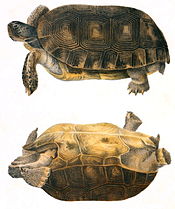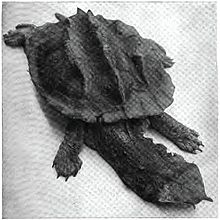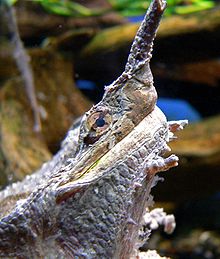- Mata mata
-
Mata mata
Temporal range: Pliocene–RecentShedds Aquarium Conservation status Scientific classification Kingdom: Animalia Phylum: Chordata Class: Reptilia Order: Testudines Suborder: Pleurodira Family: Chelidae Subfamily: Chelidinae Genus: Chelus Species: C. fimbriatus Binomial name Chelus fimbriatus
Schneider, 1783The mata mata or matamata (Chelus fimbriatus) is a freshwater turtle found in South America, primarily in the Amazon and Orinoco basins.
Contents
Taxonomy
The mata mata was described for the first time by French naturalist Pierre Barrère in 1741 as a "large land turtle with spiky and ridged scales" (translation).[1] It was first classified as Testudo fimbriata by German naturalist Johann Gottlob Schneider in 1783. It was renamed 14 different times in 2 centuries, finally being renamed Chelus fimbriatus in 1934 by Robert Mertens and Muller.[1][2][3]
Anatomy and morphology
The mata mata is a large sedentary turtle which has a large triangular flattened head characterized with many tubercles and flaps of skin and a "horn" on its long and tubular snout.[1] There are three barbels on the chin and four additional filamentous barbels at the upper jaw, which is neither hooked nor notched.[4]
The mata mata's brown or black oblong carapace can measure up to 45 cm (18 in) at adult age.[5] The full adult weight is 15 kg (33 lb).[5] The mata mata's plastron is reduced, narrowed, hingeless, shortened towards the front, and deeply notched at the rear with narrow bridges.[4] The plastron and bridges are cream to yellow or brown.[4]
The head, neck, tail, and limbs are grayish brown on adults.[4] The neck is longer than the vertebra under its carapace and is fringed with small skin flaps along both sides.[4] Hatchlings show a pink to reddish tinge in the underside edge of their carapace and plastron that gradually disappear as they grow.
Each forefoot has five webbed claws. Males have concave plastrons and longer, thicker tails than females.[4]
Habitat
The mata mata inhabits slow moving, blackwater streams, stagnant pools, marshes, and swamps ranging into northern Bolivia, eastern Peru, Ecuador, eastern Colombia, Venezuela, the Guianas, and northern and central Brazil. The mata mata is strictly an aquatic species but it prefers standing in shallow water where its snout can reach the surface to breathe.[6]
Behavior
The appearance of the mata mata's shell resembles a piece of bark, and its head resembles fallen leaves.[7] As it remains motionless in the water, its skin flaps enable it to blend into the surrounding vegetation until a fish comes close[7] The mata mata thrusts out its head and opens its large mouth as wide as possible, creating a low-pressure vacuum that sucks the prey into its mouth, known as suction feeding.[7] The mata mata snaps its mouth shut, the water is slowly expelled, and the fish is swallowed whole; the mata mata cannot chew due to the way its mouth is constructed.[7]
Reproduction
Males display for females by extending their limbs, lunging the head toward the female with mouth agape, and moving the lateral flaps on the head. Nesting occurs from October through December in the Upper Amazon. The 12 to 28 brittle, spherical, 35 mm (1.4 in) diameter eggs are deposited in a clutch.
Diet
The mata mata is carnivorous, feeding exclusively upon aquatic invertebrates and fish.[1][7]
In captivity
Mata mata turtles are readily available in the exotic pet trade and are quite expensive to obtain. Due to their unique appearance, they make interesting display animals. They also grow quite large. However, mata matas are not active hunters, so, like the alligator snapping turtle, they need less space than a large, active species.
As with all aquatic turtles, water quality is one of the keys to keeping this species successfully in captivity. Warm, acidic water is the best type used with a high tannin content that should be maintained all year round. Moderate to heavy filtration is recommended.[8]
References
- ^ a b c d Espenshade III, William H (1990), "Matamata, Chelus fimbriatus", Tortuga Gazette 26 (5): 3–5
- ^ Matamata, Chelus fimbriatus, California Turtle & Tortoise Club
- ^ Chelus fimbriatus, The Reptile Database
- ^ a b c d e f Bartlett, Dick (2007), "The Matamata", Reptiles Magazine 15 (12): 18–20
- ^ a b (French) Toutes les tortues du monde by Franck Bonin, Bernard Devaux and Alain Dupré, second edition (1998), editions Delachaux and Niestlé/WWF.
- ^ Rosenfeld, Arthur (1989), Exotic Pets, New York: Simon & Schuster, pp. 153–155, ISBN 067147654
- ^ a b c d e Cogger, Harold; Zweifel, Richard (1992), Reptiles & Amphibians, Sydney, Australia: Weldon Owen, pp. 112, ISBN 0831727861
- ^ Mata mata Care Sheet
External links
- Chelus fimbriatus, The Reptile Database
Side-necked turtle species Kingdom: Animalia · Phylum: Chordata · Class: Reptilia · Subclass: Anapsida · Order: Testudines · Suborder: Pleurodira Family Chelidae Chelodininae Chelodina canni · Chelodina longicollis · Chelodina mccordi · Chelodina novaeguineae · Chelodina reimanni · Chelodina steindachneri · Chelodina burrungandjii · Chelodina expansa · Chelodina parkeri · Chelodina rugosa · Chelodina collieiEmydura australis · Emydura macquarii · Emydura signata · Emydura subglobosa · Emydura tanybaraga · Emydura victoriaeMyuchelys latisternum · Myuchelys georgesi · Myuchelys purvisi · Myuchelys belli · Myuchelys novaeguineaePseudemyduraPseudemydura umbrinaRheodytesRheodytes leukopsChelidinae ChelusChelus fimbriatus (Mata mata)Mesoclemmys dahli · Mesoclemmys gibba · Mesoclemmys heliostemma · Mesoclemmys hogei · Mesoclemmys nasuta · Mesoclemmys perplexa · Mesoclemmys raniceps · Mesoclemmys tuberculata · Mesoclemmys vanderhaegei · Mesoclemmys zuliaePhrynops geoffroanus · Phrynops hilarii · Phrynops tuberosus · Phrynops williamsiRhinemysRhinemys_rufipesHydromedusinae Superfamily Pelomedusoidea Pelomedusinae PelomedusaPelomedusa subrufaPelusios adansonii · Pelusios bechuanicus · Pelusios broadleyi · Pelusios carinatus · Pelusios castanaeus · Pelusios castanoides · Pelusios chapini · Pelusios cupulatta · Pelusios gabonensis · Pelusios marani · Pelusios nanus · Pelusios niger · Pelusios rhodesianus · Pelusios sinuatus · Pelusios subniger · Pelusios upembae · Pelusios williamsiPodocnemidinae ErymnochelysErymnochelys madagascariensisPeltocephalusPeltocephalus dumerilianusPodocnemis expansa · Podocnemis unifilis · Podocnemis erythrocephala · Podocnemis lewyana · Podocnemis sextuberculata · Podocnemis vogliOrder Testudines (turtles) Kingdom: Animalia · Phylum: Chordata · Class: Reptilia · Subclass: Anapsida · Order: Testudines Suborder SuperfamilySubfamily
Cryptodira Caretta · Chelonia · Eretmochelys · Lepidochelys · NatatorDermochelysDermatemydidaeDermatemysStaurotypinaeBatagur · Cuora · Cyclemys · Geoclemys · Geoemyda · Hardella · Heosemys · Leucocephalon · Malayemys · Mauremys · Melanochelys · Morenia · Notochelys · Orlitia · Pangshura · Rhinoclemmys · Sacalia · Siebenrockiella · VijayachelysAldabrachelys · Astrochelys · Chelonoidis · Chersina · Cylindraspis · Geochelone · Gopherus · Homopus · Indotestudo · Kinixys · Malacochersus · Manouria · Psammobates · Pyxis · Stigmochelys · TestudoTrionychiaCarettochelyidaeCarettochelysTrionychinaePleurodira ChelidinaeChelodininaeHydromedusinaePhylogenetic arrangement based on turtles of the world 2010 update: annotated checklist. Extinct turtles not included.
See also List of Testudines families
 Portal ·
Portal ·  WikiProjectCategories:
WikiProjectCategories:- IUCN Red List least concern species
- Fauna of Guyana
- Reptiles of South America
- Chelus
Wikimedia Foundation. 2010.




